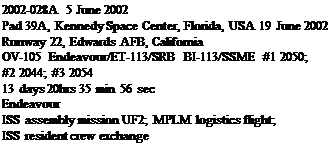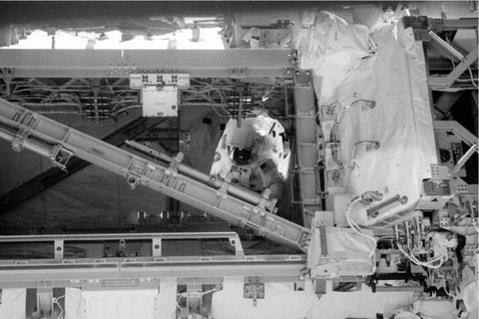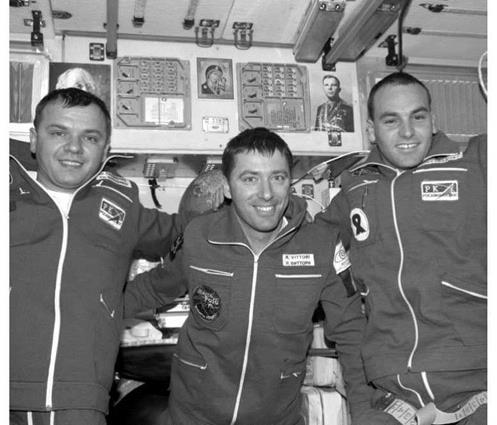STS-110
|
Int. Designation |
2002-018A |
|
Launched |
8 April 2002 |
|
Launch Site |
Pad 39B, Kennedy Space Center, Florida |
|
Landed |
20 April 2002 |
|
Landing Site |
Runway 33, Shuttle Landing Facility, KSC, Florida |
|
Launch Vehicle |
OV-104 Atlantis/ET-114/SRB BI-112/SSME #1 2048; #2 2051; #3 2045 |
|
Duration |
10 days 19 hrs 42 min 44 sec |
|
Call sign |
Atlantis |
|
Objective |
ISS assembly flight 8A; delivery of S0 Truss and Mobile Transporter |
Flight Crew
BLOOMFIELD, Michael John, 43, USAF, commander, 3rd mission Previous missions: STS-86 (1997); STS-97 (2000)
FRICK, Stephen Nathaniel, 37, USN, pilot WALHEIM, Rex Joseph, 39, USAF, mission specialist 1 OCHOA, Ellen Lauri, 43, civilian, mission specialist 2, 4th mission Previous missions: STS-56 (1993); STS-66 (1994); STS-96 (1999)
MORIN, Lee Miller Emile, 49, USN, mission specialist 3 ROSS, Jerry Lynn, 54, civilian, mission specialist 4, 7th mission Previous missions: STS 61-B (1985); STS-27 (1988); STS-37 (1991); STS-55 (1993); STS-74 (1995); STS-88 (1998)
SMITH, Steven Lee, 43, civilian, mission specialist 5, 4th mission Previous missions: STS-68 (1994); STS-82 (1997); STS-103 (1999)
Flight Log
The 4 April launch was terminated an hour into the tanking due to a leak in a LH vent line on the Mobile Launcher Platform at the pad. Following repairs to the line, the launch was rescheduled to 8 April but was delayed on the day due to drop-outs in a back-up launcher processing system. After reloading the data, the launch was achieved with just 11 seconds remaining in the launch window.
Docking with ISS occurred on FD 3 (10 Apr) and over the next 170 hours, the Shuttle crew completed 4 EVAs to install the S0 Truss. During and in between the EVAs, the astronauts transferred supplies, equipment and experiments to the station, and brought back trash and unwanted hardware. They also transferred 45 kg of oxygen and 22 kg of nitrogen to the storage tanks in Quest to re-pressurise the airlock following EVA operations. A total of 664 kg of water was transferred to the ISS, along with an experimental plant growth chamber which replaced a crystal growth experi-
|
Steve Smith works inside the S0 Truss, newly installed on ISS. Rex Walheim (out of frame) worked in tandem with Smith during the mission’s third EVA |
ment that would be returned to Earth. The crew also transferred a new freezer for future crystal sample storage.
During FD 4, the S0 Truss was lifted out of the payload bay of Atlantis by Ellen Ochoa using the station’s RMS, assisted by ISS-4 crew member Dan Bursch. It was located onto a clamp at the top of the Destiny lab, where it would serve as a platform on which other trusses would be attached and additional solar arrays mounted. The truss also included navigation devices, computers, coolant and power systems for additional laboratories and facilities to be added to the station later.
The EVAs were completed by two pairs of STS-110 astronauts. The first and third were performed by Smith (EV1) and Walheim (EV2), while the second and fourth were conducted by Ross (EV3) and Morin (EV4) (dubbed the “Silver” Team, as they were both grandfathers). EVA 1 (11 Apr for 7 hours 48 minutes) focused mainly on electrical and structural connections of the truss to the station after it had been moved from Atlantis’s payload bay. The astronauts attached four mounting struts, deployed avionics trays and connected cables from Destiny to the new addition to the station. EVA 2 (13 Apr for 7 hours 30 minutes) saw the astronauts bolt the final two struts to the lab. Launch support panels and clamps were removed and a back-up device with an umbilical reel for the Mobile Transporter railcar was also installed. EVA 3 (14 Apr for 6 hours 27 minutes) was used to reconfigure electrical connections from the US lab to the truss for powering the Canadarm2. Clamps were also released on the Mobile Transporter cart during this EVA. EVA 4 (16 Mar for 6 hours 37 minutes) saw the installation of a 4.267-metre beam called the Airlock Spur from the S0 Truss to Quest to provide a quick pathway for future EVA astronauts. Floodlights, work platforms and electrical connections were also installed and connected in this final excursion of the mission.
Initial tests of the Mobile Transporter (railcar) were successfully completed on FD 8. ISS-4 crew member Walz commanded the transporter, using a laptop computer to move it to a work site about 5.2 metres down a rail that spanned the entire length of the 13.4m truss. Then it was moved to a second site and back to the first. The unmanned cart moved about 22m in total at a rate of about 3.5 cm per second. Automatic latching did not occur due to the railcar lifting slightly, but manual latching was successfully achieved. This unit would be extended over the coming missions and would be used to ease the translation of astronauts and equipment down the length of the completed truss in future years.
Milestones
231st manned space flight 139th US manned space flight 109th Shuttle mission 25th flight of Atlantis
53rd US and 86th flight with EVA operations
13th ISS Shuttle mission
5th Atlantis ISS mission
1st person to make 7 space flights (Ross)
US career EVA record of 58 hrs 18 minutes on 9 EVAs over 4 missions (Ross)
2002-020A
25  April 2002
April 2002
Pad 1, Site 5, Baikonur Cosmodrome, Kazakhstan 5 May 2002 (in Soyuz TM33)
26 km southeast of Arkalyk
R7 (11A511U); spacecraft serial number (7K-M) 208 9 days 21 hrs 25 min 18 sec Uran (Uranus)
ISS mission 4S; Soyuz ferry exchange; Soyuz visiting mission 3; Italian Marco Polo research mission; South African SFP science mission
Flight Crew
GIDZENKO, Yuri Pavolich, 40, Russian Air Force, commander, 3rd mission Previous missions: Soyuz TM22 (1995); ISS-1 (2000)
VITTORI, Roberto, 37, Italian Air Force, flight engineer SHUTTLEWORTH, Mark, 28, civilian, South African space flight participant
Flight Log
This mission successfully exchanged the older Soyuz TM33 spacecraft for a “fresh” return capsule at ISS. In addition, Italian ESA astronaut Vittori completed a science programme for the Italian Space Agency and the second private fare-paying space flight participant (Shuttleworth) also became the first citizen from South Africa to fly into space. Soyuz TM34 docked with ISS at the Zarya nadir docking port on 27 April.
In addition to the exchange of personal effects and flight hardware required to bring home the older Soyuz and leave the newer vehicle for the ISS-4 resident crew, the two Russian commanders worked on medical experiments and a joint Russian/ German/French plasma crystal experiment during the week of joint activities. Vittori’s activities under the Marco Polo science programme included 23 sessions with four biomedical experiments. These included the relationship of the health of the individual to possible reductions in working capacity, an in-orbit test of the functional capability of a new integrated garment, and a medical experiment on the effects of space radiation on the functional state of the central nervous system and into the working capacity of the test subject. There was also a study of the vegetative regulation of arterial pressure and heart rate.
Mark Shuttleworth was determined to make his visit to the space station more scientifically rewarding and valuable than that of the previous space flight participant, Dennis Tito. He actively developed a programme of life science experiments utilising Russian equipment already aboard the station, as well as bringing four South African
|
The Soyuz Taxi-3 crew onboard the ISS. L to r Soyuz Commander Yuri Gidzenko, ESA astronaut Roberto Vittori and South African SFP Mark Shuttleworth |
university-developed experiments with him on Soyuz. One of these would focus on stem cell research. Shuttleworth also took saliva samples from himself and his crew mates as part of the embryo and stem cell development experiment.
At the end of the week’s visit, the crew packed their experiment results and cargo into the DM of Soyuz TM33. Soyuz has a limited cargo return capability and could only return 50 kg worth of cargo, of which 15 kg was allocated to the return of Italian experiment results and data. The landing of TM33 occurred without incident on 5 May, ending another highly successful visiting ferry exchange mission. It was hoped that these missions would become a regular occurrence twice a year at the station, but not with Soyuz TM. A new variant of Soyuz was waiting in the wings, and this version would have the capacity to carry taller crew members, incorporate upgrades to onboard systems and hardware and be capable of a longer orbital service life of up to a year. The flight of TM34 was therefore the last of a series that had first flown in space in May 1986.
Milestones
232nd manned space flight 93rd Russian manned space flight 86th manned Soyuz mission 33rd manned Soyuz TM mission 4th ISS Soyuz mission (3S)
3rd Soyuz ISS taxi flight 3rd ISS visiting mission Final Soyuz TM mission
1st South African citizen in space (Shuttleworth)

 |
Flight Crew
COCKRELL, Kenneth Dale, 52, civilian, commander, 5th mission Previous missions: STS-56 (1993); STS-69 (1995); STS-80 (1996); STS-98 (2001) LOCKHART, Paul Scott, 46, USAF, pilot
CHANG-DIAZ, Franklin Ramon de Los Angeles, 52, civilian, mission specialist 1, 7th mission
Previous missions: STS 61-C (1986); STS-34 (1989); STS-46 (1992); STS-60 (1994); STS-75 (1996); STS-91 (1998)
PERRIN, Philippe, 39, French Air Force, mission specialist 2 ISS-5 crew up only:
KORZUN, Valery Nikolayevich, 49, Russian Air Force, mission specialist 3, ISS-5 and Soyuz commander, 2nd mission Previous mission: Soyuz TM24 (1996)
WHITSON, Peggy Annette, 42, civilian, mission specialist 4, ISS-5 science officer
TRESCHEV, Sergei Vladimiriovich, 43, civilian, Russian mission specialist 5, ISS-5 flight engineer
ISS-4 crew down only:
ONUFRIYENKO, Yuri Ivanovich, 40, Russian Air Force, ISS-4 and Soyuz commander, mission specialist 3, 2nd mission Previous mission: Soyuz TM23 (1996)
BURSCH, Daniel Wheeler, 44, USN, ISS-4 flight engineer 1, mission specialist 4, 4th mission
Previous missions: STS-51 (1993); STS-68 (1994); STS-77 (1996)
WALZ, Carl Erwin, 46, USAF, ISS-4 flight engineer 2, mission specialist 5,
4th mission
Previous missions: STS-51 (1993); STS-65 (1994); STS-79 (1996)
|
Endeavour is shown docked to the ISS at the PMA-2 on the forward end of the Destiny laboratory. A portion of the Canadarm2 is visible in the lower left corner and the Endeavour RMS is in full view stretched out with the SO truss at its end |
Flight Log
The original 29 May launch date for this mission was scrubbed due to adverse weather conditions and the rescheduled 31 May launch was also cancelled, this time due to the discovery on 30 May of pressure differences in the left OMS pod on the Endeavour. The component would be replaced on the pad and the launch date changed to 4 June, but the unique nature of this problem meant additional work to build a test fixture, so the launch had to be delayed 24 hours to 5 June. The docking with ISS occurred on FD 3 (7 June) and the vehicles remained docked together for 189 hours. Later on FD 3, the official change-over of ISS resident crew occurred, with the ISS-4 crew formally ending their 182-day residence aboard the station and becoming part of the STS-111 crew. The ISS-5 crew, now with their seat liners in the Soyuz TM34 DM, were officially the resident crew aboard the station.
Three EVAs were completed by Chang-Diaz (EV1) and French astronaut Phillip Perrin (EV2). During their first EVA (9 Jun for 7 hours 14 minutes), they installed power and data cables and a grapple fixture to the P6 Truss, which would be used to relocate it to its final position. They also retrieved six micrometeoroid shields from Endeavour’s payload bay for temporary stowage on PMA-1. These would be installed on Zvezda by a later crew. They also inspected and photographed the failed CMG on the Z1 Truss and removed thermal blankets from the Mobile Base System before positioning it above the Mobile Transporter to thermally condition it prior to installation on the next EVA. During the second EVA (11 Jun for 5 hours), the two astronauts connected primary and back-up video and data cables between the MT railcar and MBS, and deployed an auxiliary grapple fixture on the MBS. This was called the Payload Orbital Replacement Unit Accommodation (POA) and is designed to grapple future payloads and hold on to them as they are moved across the station’s truss atop the MBS. The attachment of four bolts completed the installation of the MBS and the crew also relocated a TV camera for better views of station assembly and maintenance operations. During the final EVA (13 Jun for 7 hours 17 minutes), the astronauts replaced the faulty Canadarm2 wrist roll joint with a new unit that had been brought up to the station with them in the Shuttle’s payload bay. The faulty joint was stowed in the payload bay for return to Earth. This repair restored the station’s RMS system to operational status.
MLPM Leonardo was moved from the payload bay of Endeavour to the side of the Unity module on 8 June and remained there for unloading and loading until it was returned to the payload bay on 14 June. In the transfer of logistics, cargo, hardware and supplies to the station, the crew relocated 3,652 kg from Leonardo and a further 453 kg from lockers on Endeavour’s mid-deck. For the return to Earth, the MPLM was filled with 2,117 kg of equipment, waste and items no longer needed and a further 453 kg of returned material was located in the mid-deck lockers of the Shuttle. Among the items moved over to the station was a new science rack to house microgravity experiments, and a glove box that would permit the station crew to begin a series of experiments that required isolation conditions.
The Shuttle landed at Edwards AFB after three days of trying to land at the Cape. Low clouds, rain and thunderstorms cancelled KSC landing attempts on 17,18 and 19 June, forcing the decision to land at Edwards AFB and giving the Shuttle and ISS-4 crews an additional two days in space.
Milestones
233rd manned space flight
140th US manned space flight
110th Shuttle mission
18th flight of Endeavour
54th US and 87th flight with EVA operations
14th Shuttle ISS mission
5th Endeavour ISS mission
5th MPLM flight
3rd MPLM-1 (Leonardo) flight
1st French Shuttle crew member EVA
1st French EVA from ISS (via Quest)













